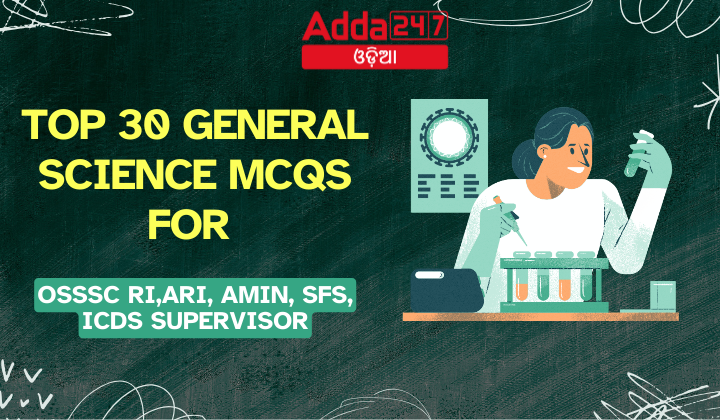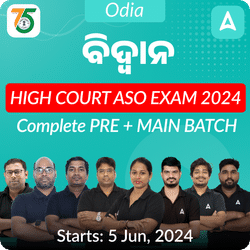General Studies is a crucial component of various competitive exams like OSSSC RI, ARI, Amin, SFS, and ICDS Supervisor. It encompasses a wide range of topics, from current affairs to history, geography, polity, and more. To excel in these exams, it’s essential to have a strong grasp of general knowledge. Here, we present a curated list of the top 30 Multiple Choice Questions (MCQs) that are commonly encountered in these exams, covering diverse subjects to help you prepare effectively.
Top 30 General Science MCQS For OSSSC RI,ARI, Amin, SFS, ICDS Supervisor
- What is a characteristic feature of a chemical change?
A) No new substances are formed.
B) Only physical state changes.
C) New substances with new properties are formed.
D) No change in chemical properties.
Answer: C
Explanation: A chemical change results in the formation of new substances with different physical and chemical properties. - When copper sulphate reacts with iron, which type of reaction occurs?
A) Combination reaction
B) Decomposition reaction
C) Single displacement reaction
D) Double displacement reaction
Answer: C
Explanation: In this reaction, iron displaces copper from copper sulphate, forming iron sulphate and copper. - Observations Indicating Chemical Reactions
Which of the following observations indicates a chemical reaction?
A) Change in temperature
B) Evolution of gas
C) Formation of a precipitate
D) All of the above
Answer: D
Explanation: All listed observations (change in temperature, evolution of gas, and formation of a precipitate) can indicate that a chemical reaction has occurred. - In a word equation, the reactants are separated from the products by:
A) A plus sign (+)
B) A minus sign (-)
C) An arrow (→)
D) An equals sign (=)
Answer: C
Explanation: Reactants and products in a word equation are separated by an arrow, which indicates the direction of the reaction. - What does the symbol “(g)” represent in a chemical equation?
A) Solid
B) Liquid
C) Gas
D) Aqueous solution
Answer: C
Explanation: The symbol “(g)” denotes a substance in the gaseous state. - According to the Law of Conservation of Mass, in a balanced chemical equation, the:
A) Number of atoms for each element must be equal on both sides
B) Number of molecules must be equal on both sides
C) Mass of reactants must be less than the mass of products
D) Mass of reactants must be more than the mass of products
Answer: A
Explanation: The Law of Conservation of Mass states that atoms are neither created nor destroyed in a chemical reaction, so the number of atoms for each element must be the same on both sides of the equation. - Which of the following properties is characteristic of acids?
A) They turn red litmus blue.
B) They have a bitter taste.
C) They turn blue litmus red.
D) They feel slippery to the touch.
Answer: C
Explanation: Acids turn blue litmus paper red, indicating their acidic nature. - Which of the following is a property of bases?
A) Sour taste
B) Turns blue litmus red
C) Reacts with metals to produce hydrogen gas
D) Turns red litmus blue
Answer: D
Explanation: Bases turn red litmus paper blue, which is a characteristic property of bases. - What is a salt in chemistry?
A) A compound that donates protons
B) A compound that accepts electrons
C) A neutral compound formed by the reaction of an acid with a base
D) A substance that turns red litmus blue
Answer: C
Explanation: A salt is a neutral compound produced by the reaction of an acid with a base. - What is the pH range for bases (alkalis)?
A) 0-7
B) 7-14
C) 1-7
D) 0-14
Answer: B
Explanation: The pH range for bases is 7-14, with 7 being neutral and anything above 7 being basic. - Which acid is commonly used in lead-acid batteries?
A) Hydrochloric acid
B) Acetic acid
C) Sulfuric acid
D) Nitric acid
Answer: C
Explanation: Sulfuric acid is used in lead-acid batteries due to its strong acidic properties and ability to provide the necessary reactions. - What is produced when sodium bicarbonate is heated?
A) Sodium hydroxide
B) Sodium carbonate, carbon dioxide, and water
C) Sodium chloride and water
D) Sodium sulfate and water
Answer: B
Explanation: When sodium bicarbonate is heated, it decomposes to form sodium carbonate, carbon dioxide, and water. - What type of reaction occurs between an acid and a base?
A) Decomposition
B) Combination
C) Displacement
D) Neutralization
Answer: D
Explanation: The reaction between an acid and a base is called a neutralization reaction, producing a salt and water. - What is the typical pH value of acid rain?
A) 7.0
B) 6.5
C) Less than 5.6
D) Greater than 7.0
Answer: C
Explanation: Acid rain has a pH value less than 5.6 due to the presence of sulfuric and nitric acids formed from atmospheric pollutants. - What is the pH value of a neutral solution?
A) 0
B) 7
C) 14
D) 5
Answer: B
Explanation: A pH value of 7 indicates a neutral solution, such as pure water. - Which of the following is an alloy?
A) Copper
B) Zinc
C) Brass
D) Aluminum
Answer: C
Explanation: Brass is an alloy of copper and zinc. - Which of the following is the molecular formula for methane?
A) CH3
B) CH4
C) C2H6
D) C3H8
Answer: B
Explanation: Methane has the molecular formula CH4. - In which state of matter do particles have the highest kinetic energy?
A) Solid
B) Liquid
C) Gas
D) Plasma
Answer: D
Explanation: Plasma, a state of matter where gas is ionized, has particles with the highest kinetic energy. - Which phenomenon explains why a straw appears bent when placed in a glass of water?
A) Reflection
B) Refraction
C) Diffraction
D) Dispersion
Answer: B
Explanation: Refraction is the bending of light as it passes from one medium to another. - What part of the human eye is responsible for controlling the amount of light entering it?
A) Retina
B) Cornea
C) Pupil
D) Lens
Answer: C
Explanation: The pupil controls the amount of light that enters the eye by changing its size. - What is the unit of electric current?
A) Volt
B) Ampere
C) Ohm
D) Watt
Answer: B
Explanation: The unit of electric current is the ampere (A). - What is the direction of the magnetic field inside a current-carrying solenoid?
A) Circular
B) Parallel to the axis
C) Radial
D) Perpendicular to the axis
Answer: B
Explanation: The magnetic field inside a current-carrying solenoid is parallel to the axis of the solenoid. - Which vitamin is necessary for blood clotting?
A) Vitamin A
B) Vitamin C
C) Vitamin K
D) Vitamin D
Answer: C
Explanation: Vitamin K is essential for the process of blood clotting. - Which gas is primarily exhaled during respiration?
A) Oxygen
B) Nitrogen
C) Carbon dioxide
D) Methane
Answer: C
Explanation: Carbon dioxide (CO2) is the primary gas exhaled during respiration. - What type of blood vessels carry blood away from the heart?
A) Veins
B) Capillaries
C) Arteries
D) Venules
Answer: C
Explanation: Arteries carry blood away from the heart. - Where does fertilization typically occur in the human body?
A) Ovary
B) Uterus
C) Fallopian tube
D) Cervix
Answer: C
Explanation: Fertilization usually occurs in the fallopian tube. - What is the basic unit of heredity?
A) Cell
B) Gene
C) Chromosome
D) Protein
Answer: B
Explanation: The gene is the basic unit of heredity. - Which of the following is a non-renewable resource?
A) Solar energy
B) Wind energy
C) Coal
D) Hydropower
Answer: C
Explanation: Coal is a non-renewable resource because it cannot be replenished on a human timescale. - How much water can a camel store in its hump?
a) 0 liters
b) 10 liters
c) 50 liters
d) 100 liters
Answer: a) 0 liters
Solution:
Camels do not store water in their humps. Instead, their humps are filled with fatty tissue which they can metabolize for energy and water when food and water are scarce. When a camel metabolizes this fat, it releases water as a byproduct, but the hump itself does not contain stored water. - How strong does a non-toxic odor have to be before it damages your sense of smell?
a) 5 ppm (parts per million)
b) 50 ppm
c) 500 ppm
d) 5,000 ppm
Answer: d) 5,000 ppm
Solution:
Non-toxic odors can damage the sense of smell if they are present at extremely high concentrations. For most non-toxic substances, exposure to concentrations of 5,000 ppm (parts per million) or higher can potentially damage olfactory cells and impair the sense of smell.










